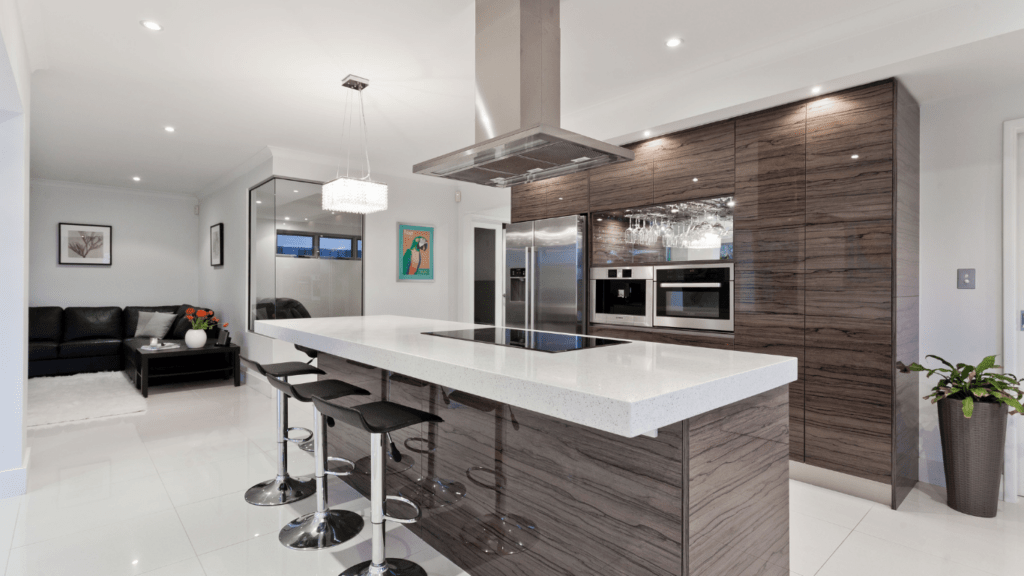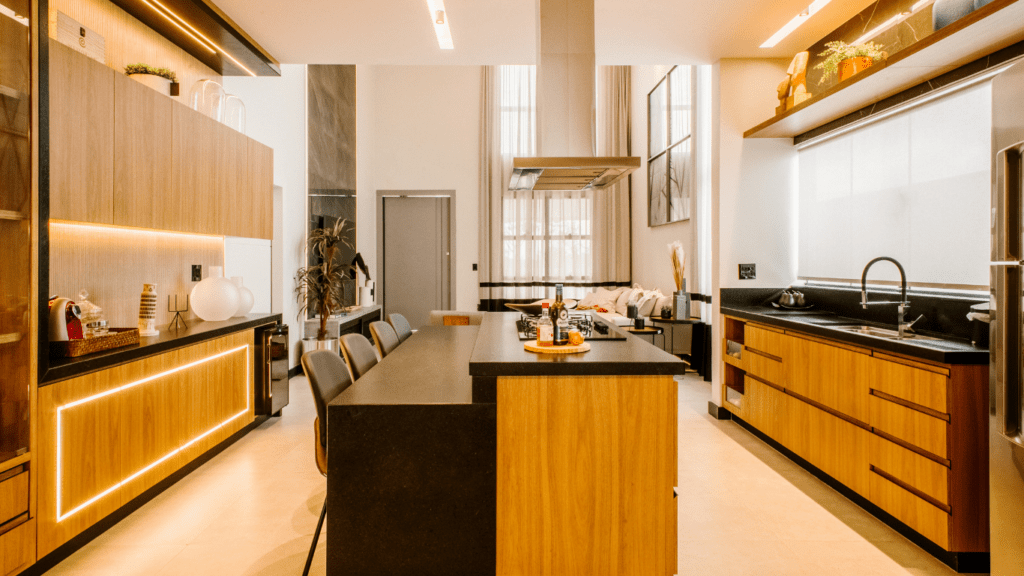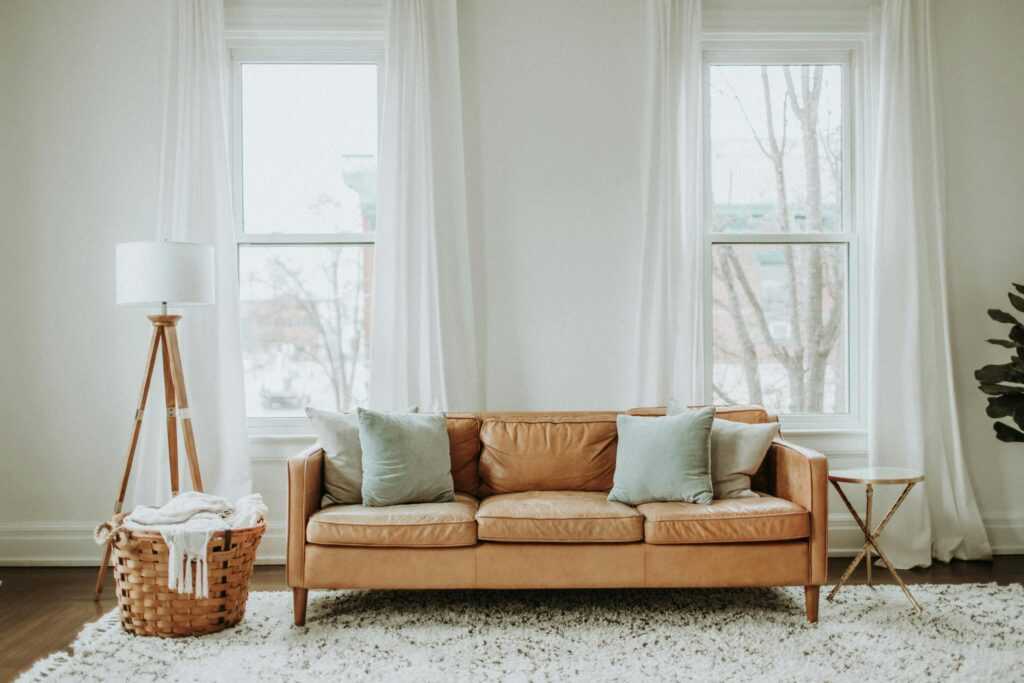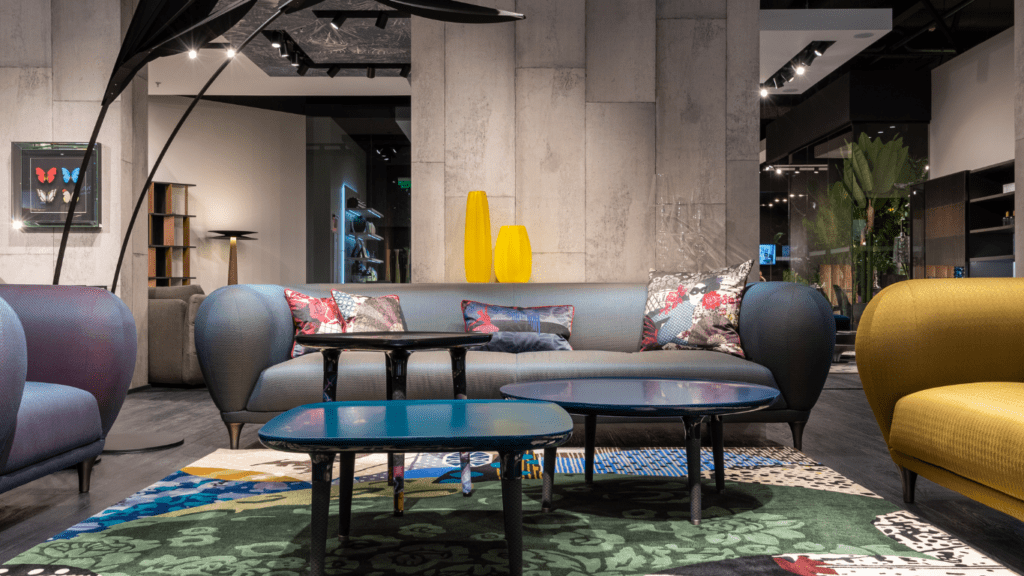Sustainable Materials
In 2024, sustainable materials take center stage in kitchen design. Incorporating these elements not only benefits the environment but also adds a unique touch to any kitchen space.
Recycled Elements
Recycled elements, such as reclaimed wood and recycled glass countertops, are becoming staples in modern kitchens. Reclaimed wood, sourced from old barns and factories, offers character through its unique grains and hues. Recycled glass countertops blend aesthetics with sustainability, utilizing post-consumer glass to create durable surfaces. Both materials reduce waste and conserve natural resources while providing stylish yet eco-friendly options.
Eco-Friendly Appliances
- Eco-friendly appliances, like energy-efficient dishwashers and refrigerators, play a vital role in sustainable kitchen design.
- Energy-efficient dishwashers use less water and electricity, cutting down on utility bills and environmental impact.
- Similarly, energy-efficient refrigerators feature advanced insulation and compressor technologies, keeping food fresher longer while reducing energy consumption.
- These appliances, certified by Energy Star, ensure that sustainability extends to every corner of the kitchen.
Bold Color Choices
Bold color choices are transforming kitchen aesthetics in 2024. Vibrant hues create focal points, enhance mood, and imbue kitchens with personality.
Statement Backsplashes
Statement backsplashes become a centerpiece in modern kitchens by incorporating bold colors and intricate patterns. Glass tiles in bright blues, geometric mosaics with contrasting tones, and hand-painted ceramics elevate the backsplash from a mere functional element to a defining feature of the kitchen. Opt for mixtures of red and orange for a warm, energetic vibe or deep greens and blues for a calming, earthy effect. Bold backsplashes complement both minimalist and maximalist designs, acting as a versatile centerpiece.
Two-Tone Cabinets
Two-tone cabinets are gaining popularity for adding depth and contrast to kitchen spaces. This design approach involves using a darker color for lower cabinets and a lighter shade for upper ones, creating a balanced look. For example, pair deep navy bottom cabinets with crisp white uppers, or blend forest green with light gray. This technique highlights different areas of the kitchen, making the space feel larger and more dynamic. Two-tone cabinets break the monotony, offering visual interest and allowing for personalized style combinations.
Smart Technology Integration
Integrating smart technology into kitchen design is revolutionizing functionality and convenience. Embracing these advancements can transform ordinary kitchens into highly efficient spaces.
Touchless Faucets
Touchless faucets enhance hygiene and convenience. They use motion sensors to activate water flow, reducing contact with surfaces and minimizing the spread of germs. Many models offer adjustable flow rates and temperature settings, controlled via smartphone apps. For instance, Delta and Moen have popular touchless faucets with intuitive designs that blend seamlessly into modern kitchens.
Smart Ovens and Refrigerators
Smart ovens and refrigerators bring connectivity and automation to cooking and food storage. Smart ovens feature Wi-Fi connectivity, allowing remote control and monitoring through dedicated apps. Features like automatic preheating and recipe-guided cooking improve efficiency. Brands like Samsung and GE have models incorporating these features.
Smart refrigerators offer inventory management and energy efficiency. With internal cameras and smart sensors, users can monitor contents and track expiration dates. Voice control capabilities through platforms like Alexa and Google Assistant add ease of use. LG and Bosch offer high-end smart refrigerators that enhance both storage and energy management.
Minimalist Designs

Embracing minimalism in kitchen design means creating a space that is clean, functional, and aesthetically pleasing. The trends for 2024 lean heavily towards simplicity and streamlined appearances.
Sleek Cabinetry
Minimalist kitchens feature sleek cabinetry that hides hinges, handles, and other hardware. Streamlined designs use flat-panel doors and high-gloss finishes to maintain a smooth, uninterrupted look. Examples include handleless cabinets that open with a push mechanism and integrated finger pulls that blend seamlessly with the cabinet’s surface. Using neutral colors like white, beige, or soft gray enhances the minimalist appeal.
Hidden Storage Solutions
- Efficient storage maintains the clean lines of a minimalist kitchen.
- Hidden storage solutions, such as pull-out pantries and built-in organizers, keep countertops clutter-free.
- Concealed appliances, like built-in refrigerators and dishwashers masked by cabinet panels, ensure a uniform look.
- Inside drawers, clever dividers and drawer inserts maximize space usage and accessibility.
- These innovations support the minimalist ethos by enhancing both functionality and visual simplicity.
Multifunctional Spaces
Multifunctional spaces are revolutionizing kitchen design in 2024. They maximize utility and aesthetics, making kitchens more versatile and efficient.
Kitchen Islands with Seating
Kitchen islands serve as central hubs. They offer additional counter space and storage, enhancing functionality. Islands with integrated seating options create casual dining areas. For instance, bar stools or built-in benches can transform an island into an informal dining spot, blending work and relaxation spaces seamlessly. A combination of wood and metal seating options ensures durability and style, catering to different tastes.
Built-In Appliances
Built-in appliances streamline kitchen spaces. They offer a sleek, cohesive look while saving valuable counter space. Examples include:
- ovens
- microwaves
- dishwashers
that fit seamlessly within cabinetry. These appliances enhance both form and function, maintaining a clean, uncluttered kitchen aesthetic. Built-in refrigerators and coffee makers illustrate how to integrate technology without sacrificing style. Attention to detail in integrating appliances ensures an organized, modern kitchen layout.



 Smart Home Technology Consultant
Meagan Kanedooray serves as Luxe House Maker’s smart home technology consultant, with extensive experience in integrating advanced tech into luxury homes. Specializing in home automation, security systems, and energy-efficient solutions, Meagan helps readers transform their living spaces into seamless, tech-enabled environments. Her expertise in cutting-edge technologies ensures that Luxe House Maker’s audience stays informed about the latest innovations that enhance convenience, safety, and sustainability in luxury living. Meagan’s deep understanding of smart home trends makes her an invaluable resource for those looking to elevate their homes with the latest advancements in technology.
Smart Home Technology Consultant
Meagan Kanedooray serves as Luxe House Maker’s smart home technology consultant, with extensive experience in integrating advanced tech into luxury homes. Specializing in home automation, security systems, and energy-efficient solutions, Meagan helps readers transform their living spaces into seamless, tech-enabled environments. Her expertise in cutting-edge technologies ensures that Luxe House Maker’s audience stays informed about the latest innovations that enhance convenience, safety, and sustainability in luxury living. Meagan’s deep understanding of smart home trends makes her an invaluable resource for those looking to elevate their homes with the latest advancements in technology.
